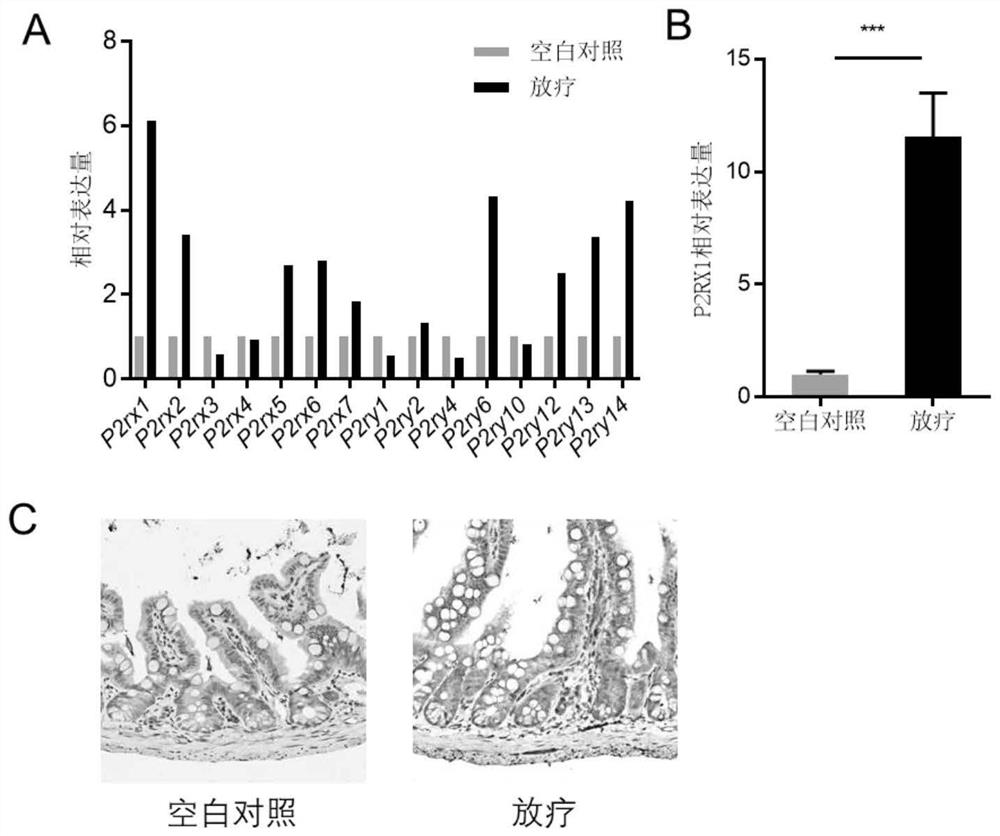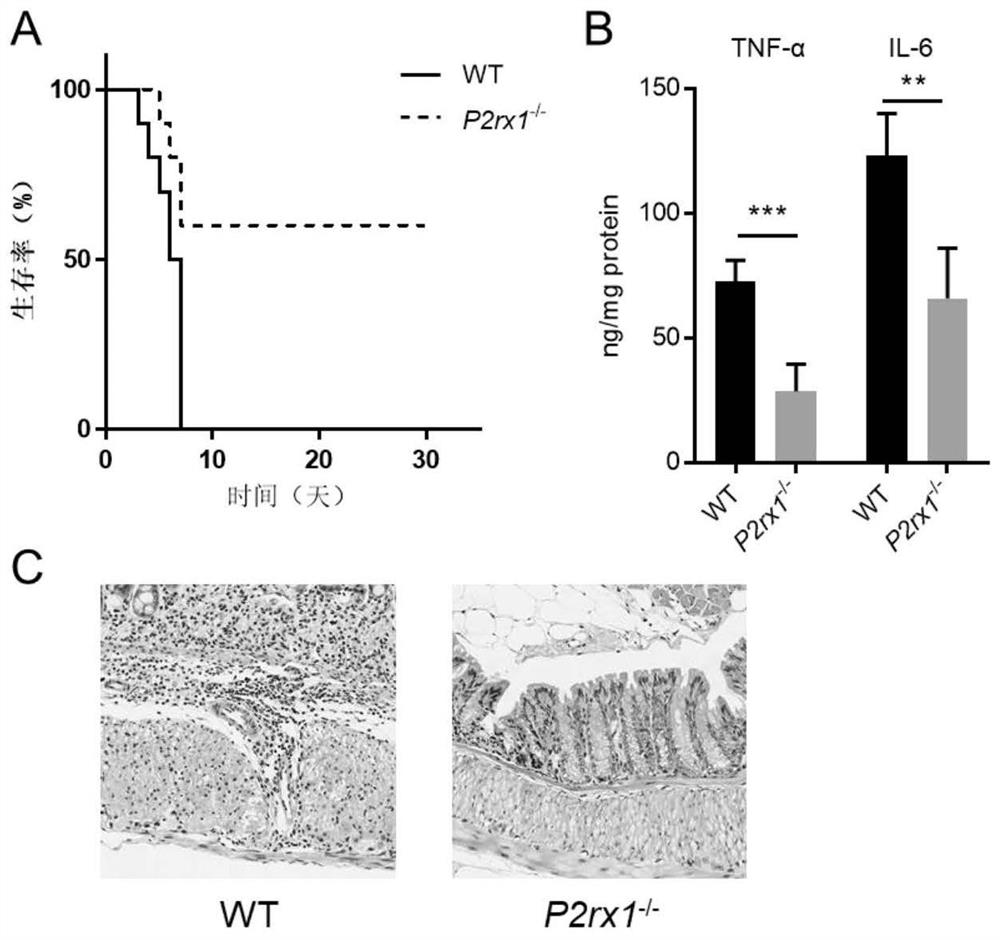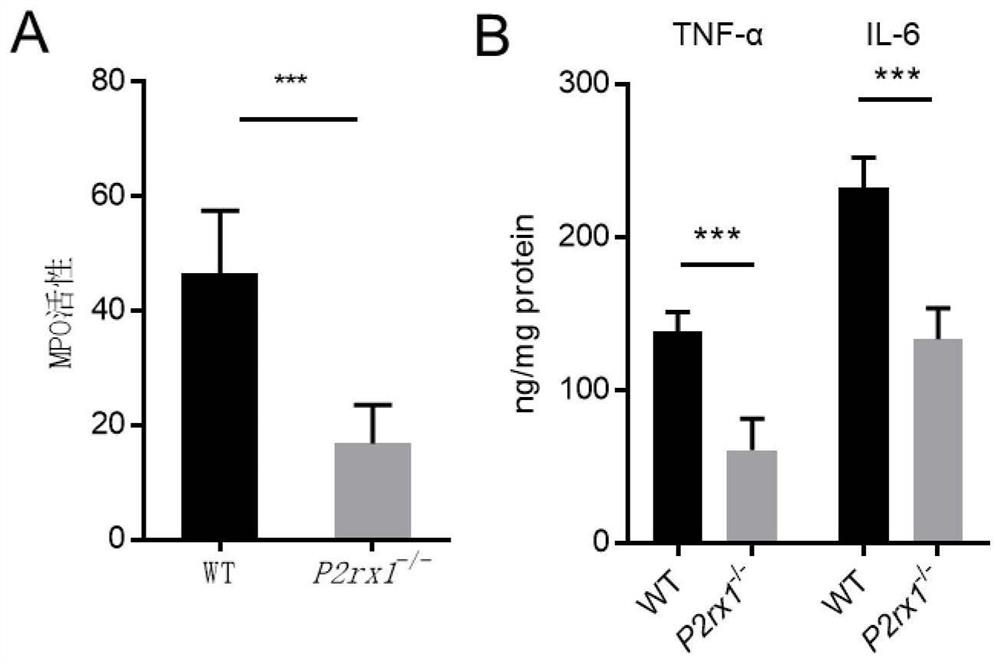Medicine for treating acute radiation enteritis
A radiation enteritis, acute technology, applied in the direction of drug combination, pharmaceutical formula, medical preparations containing active ingredients, etc., can solve problems such as no related reports, and achieve the effect of good application prospects
- Summary
- Abstract
- Description
- Claims
- Application Information
AI Technical Summary
Problems solved by technology
Method used
Image
Examples
Embodiment 1
[0033] Example 1 Effect of radiotherapy on the expression of purinergic signal receptors in mouse intestines P2RXs and P2RYs
[0034] 1. Experimental method
[0035] (1) Animals and groups
[0036] Twelve SPF grade C57BL / C male mice, each weighing 24-26 g, were divided into two groups according to random number method, namely blank control group and radiotherapy group (n=6). The mice in the radiotherapy group were irradiated with X-rays at one time, with a total dose of 10Gy, to establish an acute radiation injury model. The blank control group did not receive X-ray irradiation, and the rest of the experimental conditions were the same as those of the radiotherapy group.
[0037] (2) RNA sample preparation and detection
[0038] After 2 days of radiotherapy, mice were treated with CO 2 Euthanasia was performed by asphyxiation, and the small intestine tissue was removed, and the contents of the intestine were carefully squeezed out and placed in Trizol. The small intestine...
Embodiment 2
[0052] Example 2 P2RX1 gene knockout improves the survival rate of mice after radiotherapy and inhibits acute radiation enteritis
[0053] 1. Experimental method
[0054] (1) Animals and groups
[0055] SPF-grade wild-type (WT) mice and P2RX1 knockout (P2rx1 - / - ) mice (Jiangsu Jicui Yaokang Co., Ltd.), 15 males, each weighing 24-26 g. Mice were irradiated with X-ray whole body at one time, with a total dose of 10Gy, to establish an acute radiation injury model.
[0056] (2) Survival rate analysis
[0057] The survival rate of the mice was continuously observed for 30 days after radiotherapy, and the survival conditions of the mice were recorded (n=10).
[0058] (3) HE staining
[0059] After 2 days of radiotherapy, mice were treated with CO 2 Euthanasia was performed by asphyxiation, small intestinal tissue was harvested, and intestinal contents were carefully squeezed out. Tissues were fixed with formalin fixative and embedded in paraffin. Sections were HE stained (n...
Embodiment 3
[0064] Example 3 P2RX1 Gene Knockout Inhibits Inflammatory Activation of Neutrophils in Mice After Radiotherapy
[0065] 1. Experimental method
[0066] (1) Animals and groups
[0067] SPF-grade wild-type (WT) mice and P2RX1 knockout (P2rx1 - / - ) 5 male mice, each weighing 24-26 g. Mice were irradiated with X-ray whole body at one time, with a total dose of 10Gy, to establish an acute radiation injury model.
[0068] (2) Detection of intestinal MPO (myeloperoxidase) activity
[0069] After 2 days of radiotherapy, mice were treated with CO 2 Euthanasia was performed by asphyxiation, small intestinal tissue was harvested, and intestinal contents were carefully squeezed out. The MPO activity of the small intestine tissue was detected according to the instructions of the MPO kit (Abcam, ab105136).
[0070] (3) Detection of neutrophil inflammatory factors
[0071] After 2 days of radiotherapy, mice were treated with CO 2 Euthanasia was performed by asphyxiation, peripheral ...
PUM
 Login to View More
Login to View More Abstract
Description
Claims
Application Information
 Login to View More
Login to View More - R&D Engineer
- R&D Manager
- IP Professional
- Industry Leading Data Capabilities
- Powerful AI technology
- Patent DNA Extraction
Browse by: Latest US Patents, China's latest patents, Technical Efficacy Thesaurus, Application Domain, Technology Topic, Popular Technical Reports.
© 2024 PatSnap. All rights reserved.Legal|Privacy policy|Modern Slavery Act Transparency Statement|Sitemap|About US| Contact US: help@patsnap.com










